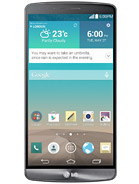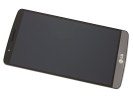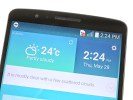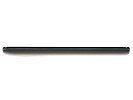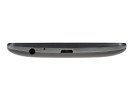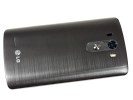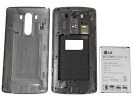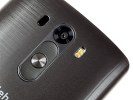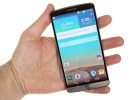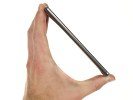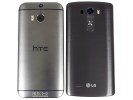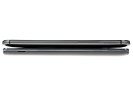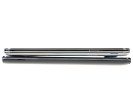LG G3 Radiation Levels
Head SAR| Radiation Levels | HEAD | BODY | HOT SPOT |
|---|---|---|---|
| Cellular Only | 0.21 W/kg | 0.68 W/kg | 0.76 W/kg |
| Wi-Fi + Cellular | 0 W/kg | 0 W/kg | 0 W/kg |
Select a phone to compare SAR levels to other popular phones
LG G3 Safety Tip: Turning Off Wi-Fi and Bluetooth Reduces Radiation.
This SAR chart reveals how turning off Wi-Fi and Bluetooth on your LG G3 can significantly reduce your exposure to radiation. Our SAR comparison chart shows that by simply turning off these transmitters, you can lower the RF radiation exposure to your head by %, and you can lower exposure to the body by %, when considering these differences between cellular-only (Wi-Fi/Bluetooth OFF) and simultaneous use exposure (Wi-Fi/Bluetooth ON), a wise way to reduce excessive phone radiation is to tap off unnecessary transmitters when not in use. Additionally, when using your phone as a hotspot, turning off Bluetooth can reduce your exposure by up to 100% according to the FCC SAR report for device number ZNFD855.
LG G3 SAR Levels
| RADIATION LEVELS | CELLULAR ONLY | (% DIFF) | SIMULTANEOUS |
|---|---|---|---|
| HEAD | 0.21 W/kg | % | W/kg |
| BODY | 0.68 W/kg | % | W/kg |
| HOTSPOT | 0.76 W/kg | 100% | W/kg |
Key Takeaways
- Children vs Adults: Children have higher SAR levels due to thinner skulls and developing tissues, making them more vulnerable to radiation.
- Wi-Fi Impact: Simultaneous use of cellular and Wi-Fi transmission increases SAR levels for all age groups.
- Precautionary Measures: Using radiation protection products like QuantaCase can help mitigate these risks, especially for younger users.
By understanding these differences, parents and guardians can make informed decisions to better protect their children from excessive microwave radiation exposure, emphasizing the need for safer smartphone usage practices and protective accessories like QuantaCase.

Avoid Excessive g3 Cell Phone Radiation!
To minimize the potential health risks associated with cell phone radiation, it’s important to reduce exposure as much as possible. This can be achieved by using hands-free devices and keeping the phone away from the body, as well as by using a phone case with built-in radiation shielding technology.
The best example is the RF Safe® g3 QuantaCase™ RFS1. This case is designed to deflect the strongest line-of-sight radiation away from the body while not obstructing the phone’s antenna. RF shielding technology reduces excessive radiation exposure across a wide range of radio frequencies, including 5G, Wi-Fi, and cellular. Additionally, the case features an integrated single-slot RFID-blocking wallet for added security.
The QuantaCase RFS1 provides RFID and anti-radiation protection without any conductive or signal-impeding components in the back of the case, allowing the phone to operate at its lowest possible output level and reducing the amount of harmful radiation emitted. The case also protects the phone from scratches, cracks, and dings.
To use the RF Safe® g3 QuantaCase™ RFS1 effectively, it’s recommended to always close the front flip cover and use the speakerphone when privacy is not an issue. When storing in a pocket, face the front flap towards the body to deflect the strongest line-of-sight radiation. When texting, fold the flap behind the phone to shield the back while held in hand.
It’s important to keep in mind that maintaining a distance from the phone is the best way to reduce EMF exposure. However, using a phone case with built-in radiation shielding technology like the RF Safe® g3 QuantaCase™ RFS1 can provide an extra layer of protection in an ultra-thin design.
The Specific Absorption Rate (SAR) of a mobile device measures the amount of radio frequency energy absorbed by the body during device usage.
The SAR values for the g3 (FCC ID ZNFD855) are as follows:
- 0.21 W/kg when held at the head with cellular transmission only
- 0.68 W/kg when worn on the body with cellular transmission only
- 0.76 W/kg when used as a Hotspot or Airplay
- 0 W/kg when held at the head with simultaneous cellular and Wi-Fi transmission
- 0 W/kg when worn on the body with simultaneous cellular and Wi-Fi transmission
- when used as a Hotspot simultaneously with other transmitters active.
LG G3
LG G3 - Specs sar
General
-
Announced
01 May 2014
-
Status
Available
Display
-
Features
Pixel Density (PPI) is refers to the concentration of pixels on a particular display, measured in pixels per inch (ppi). Pixel density is calculated by dividing the diagonal pixel resolution of a display by its diagonal size, higher pixel density better display quality. Corning Gorilla Glass 3
Camera
Battery
Hardware
-
Chipset
Chipset is a group of integrated circuits designed to perform one or a more dedicated functions, often with real time computing constraints, Popular smartphones are equipped with more advanced embedded chipsets that can do many different tasks depending on their programming. Qualcomm MSM8975AC Snapdragon 801
-
CPU
CPU (Central Processing Unit) mostly known as processors, CPU processes instructions in order to carry out certain functions that make your device operate properly. Processors are often described as the brain of computers, smartphones and tablets, Smartphones and tablets rely on processors to carry out their every task, Processors are an incredibly important factor in selecting any type of computing device, including your smartphone. Quad-core 2.5 GHz Krait 400
-
GPU
GPU (Graphics Processing Unit) is a single-chip processor designed to rapidly manipulate and alter memory to accelerate the creation of images in a frame buffer intended for output to a display, This includes things such as lighting effects, object transformations, and 3D motion. Adreno 330
-
Card Slot
Memory Card Slot is a special slot for inserting a memory card. Memory cards allow you to expand the phone's built-in memory, A memory card (sometimes called a flash memory card or a storage card) is a small storage medium used to store data such as text, pictures, audio, and video, for use on small, portable or remote computing devices such as mobile phones, mp3 players, digital cameras. Card slot microSD, up to 128 GB
-
Sensors
Sensors are electronic components that detects and responds to some type of input from the physical environment. The specific input could be light, heat, motion, moisture, pressure and location, The output is generally a signal that is converted to use in computing systems, a location sensor, such as a GPS receiver is able to detect current location of your electronic device. Accelerometer, gyro, proximity, compass
Connectivity
-
Bluetooth
Bluetooth is a wireless communications technology for exchanging data between mobile phones, headsets, computers and other network devices over short distances without wires, Bluetooth technology was primarily designed to support simple wireless networking of personal consumer devices. v4.0, A2DP, LE, apt-X
-
USB
microUSB v2.0 (SlimPort), USB Host
Sound
Design
-
Type
Design Type called form factor refers to a mobile phone's size, shape, and style as well as the layout and position of major components of phone. There are three major form factors seen in mobile phones => bar phones, flip phones and sliding phones. Bar
-
Dimensions
146.3 x 74.6 x 8.9 mm (5.76 x 2.94 x 0.35 in)
-
Weight
149 g (5.26 oz)
-
Colors
Metallic Black, Silk White, Shine Gold, Moon Violet, Burgundy Red, Blue Steel
Network
-
SIM
Standard SIM
USA SAR Level
-
FCC Approval Date
30 May 2014
-
FCC ID
ZNFD855
- FCC Report Link
-
US SAR Ratings
USA Legal Limit is 1.6 W/kg - FCC SAR testing is measured in watts per kilogram (or W/kg) averaged over ONE gram of simulated biological tissue. It is a well known FACT SAR testing was not designed for protecting women or children from harmful radiation exposure, and SAR Test do not take into consideration health effects below thermal levels
-
Head SAR Level
0.21
-
Body SAR Level
0.68
-
Product Specific Use
0.76
-
Simultaneous Transmission
0.99
-
Simultaneous Head SAR
N/A
-
Simultaneous Body SAR
N/A
-
Hotspot SAR
N/A
EU SAR Level
-
EU SAR Ratings
European Legal Limit is 2.0 W/kg - EU SAR testing is measured in watts per kilogram (or W/kg) averaged over TEN grams of simulated biological tissue.
-
Head SAR Level
0.23 W/kg
-
Body SAR Level
N/A
-
Simultaneous Head SAR
N/A
-
Simultaneous Body SAR
N/A
-
Hotspot SAR
N/A
LG G3 - Reviews
[products limit="1" columns="1" category="quantacase-rfs1, g3" cat_operator="AND" orderby="date"]LG G3 - Gallery
LG G3 - Videos
LG G3 - Offers
LG G3 - SAR Levels
USA SAR Level
-
FCC Approval Date
30 May 2014
-
FCC ID
ZNFD855
- FCC Report Link
-
US SAR Ratings
USA Legal Limit is 1.6 W/kg - FCC SAR testing is measured in watts per kilogram (or W/kg) averaged over ONE gram of simulated biological tissue. It is a well known FACT SAR testing was not designed for protecting women or children from harmful radiation exposure, and SAR Test do not take into consideration health effects below thermal levels
-
Head SAR Level
0.21
-
Body SAR Level
0.68
-
Product Specific Use
0.76
-
Simultaneous Transmission
0.99
-
Simultaneous Head SAR
N/A
-
Simultaneous Body SAR
N/A
-
Hotspot SAR
N/A
EU SAR Level
-
EU SAR Ratings
European Legal Limit is 2.0 W/kg - EU SAR testing is measured in watts per kilogram (or W/kg) averaged over TEN grams of simulated biological tissue.
-
Head SAR Level
0.23 W/kg
-
Body SAR Level
N/A
-
Simultaneous Head SAR
N/A
-
Simultaneous Body SAR
N/A
-
Hotspot SAR
N/A

